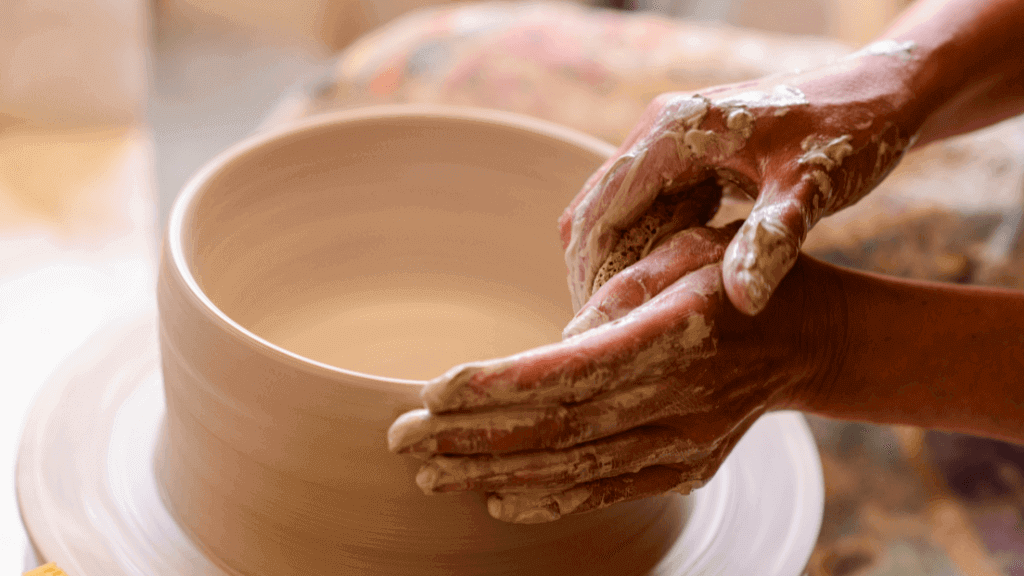It is possible to make money selling pottery, though it takes time and effort to master the techniques. Mid-level potters earn around $20/hour, while senior potters earn up to $30/hour. Selling pottery online can also be profitable, with 1000 followers potentially earning a potter up to $30 per post. Dedication and skill make it possible to make big money making pottery to sell.
Step 1: Motivate Yourself and Build Confidence
Is Pottery Profitable?
Yes, it is possible to make money selling pottery, but you need dedication, skill, and effort. Before diving in, ponder these critical questions:
- Can you take pieces to Art Stores? Offering pottery in art-focused venues might attract a higher-paying clientele.
- Is it logical to think of loss before starting a business? While every business comes with risks, having a positive mindset is essential.
- Is choosing pottery as a living a waste of money or time? No. However, profitability varies. While mid-level potters might earn around $20/hour, senior potters can go up to $30/hour. On platforms like Instagram, having 1,000 followers can earn up to $30 per post.
Step 2: Gain Experience
Working for Potters: This step is valuable, especially for new ones. You’ll learn techniques and business nuances.
Practice: Beyond artistic talent, you need practice to hone your skills. Another advantage besides the experience is understanding the market. You’ll grasp what sells, customer preferences, and pricing strategies.
Step 3: Strategize your Pottery Business Plan
What makes your pottery stand out? Your unique style can be your USP (Unique Selling Proposition).
A pottery business strategy also includes where to sell:
- Turn your pottery studio into a shop: Let clients see and buy firsthand.
- Sell to pottery retailers: They can take the bulk of your creations.
- Selling pottery online: Sites like Etsy are great platforms. Selling pottery online can be especially profitable if done right.
- Set up a Pottery booth: Local fairs and festivals can be a goldmine.
Now, Let’s Focus on Business Planning: Remember to factor in production costs, including materials, firing, taxes, and labor, when determining prices.
Step 4: Set Up a Pottery Workspace
Having a dedicated workspace is crucial for efficiency and productivity. When setting up:
- Space: Make ample room for crafting, drying, and storing pottery. This also includes space for a pottery wheel, kiln, and storage racks.
- Organization: Organize tools and materials for easy access. This reduces time searching for items and helps streamline the production process.
- Safety: Pottery can be messy, and kilns can pose fire risks. Ensure your workspace is well-ventilated and you have safety equipment like gloves and masks.
- Inspiration: Personalize your space. Whether it’s a mood board or calming colors on the walls, make your workspace a place of creativity and inspiration.
Step 5: Create Pottery Pieces
It’s not just about making pottery; it’s about creating art:
- Consistency: While each piece might be unique, maintaining a consistent quality ensures customer trust.
- Research: Stay updated with the latest pottery trends. Understand what customers are buying and incorporate that knowledge.
- Experimentation: Don’t be afraid to try new techniques or styles. This keeps your collection fresh and appealing.
- Feedback: Take in reviews and feedback from customers. It can guide you in refining your creations.
Step 6: Create a Logo and Market for your Pottery Business
Branding goes beyond just a name:
- Logo Design: Your logo should encapsulate the essence of your pottery business. It’s the first visual cue potential customers will associate with your brand. Consider professional help if needed.
- Online Presence: In today’s digital age, an online presence isn’t optional; it’s essential. Build a user-friendly website with high-quality images of your pottery.
- Social Media: Platforms like Instagram, Pinterest, and Facebook aren’t just for personal use; they’re powerful business tools. Regularly post updates, run promotions, and engage with your audience.
- SEO and Paid Ads: Optimize your website for search engines (SEO) to attract organic traffic. Additionally, consider investing in paid ads for added visibility on platforms where potential customers hang out.
Step 7: Sell Your Pottery and Grow Your Business
How much can you make selling pottery? Apart from standard sales, consider seasonal sales, which can spike earnings. Once your pricing is finalized, showcase your pieces on your website and social media platforms. Running an online store or hosting sales events can further enhance your reach.
While a pottery business is profitable, success hinges on strategy, quality, and marketing. Whether selling pottery online or offline, the potential is immense if approached correctly.
Step 8: Where to Sell Your Pottery?
Finding the right places to sell your pottery is vital for reaching your target audience and maximizing profitability. Here’s an extensive list of both offline and online venues:
Offline Venues:
- Craft Fairs & Art Shows: A traditional favorite, these events attract art enthusiasts and offer an excellent opportunity to display your work and interact with customers.
- Local Art Galleries: Galleries are great places for artists to showcase their pottery and tap into an audience that appreciates art.
- Pottery Workshops: Conducting workshops can help you earn from teaching and selling your creations to attendees.
- Coffee Shops & Restaurants: Many local coffee shops and eateries showcase local art for sale, and pottery can often be a perfect fit.
- Farmers Markets: A favorite for handmade items, your pottery can find a home amidst organic veggies and homemade jams.
- Boutique Retail Stores: Some boutique stores love to keep handcrafted items, adding to their unique product lineup.
- Consignment Shops: These stores can display your pottery, and you’ll earn a commission upon sale.
- Local Gift Shops: Tourists often visit local gift shops for unique items. Your pottery can be a hit among visitors wanting to take home a piece of local art.
Online Venues:
- Etsy: A top platform for handcrafted items, Etsy has a global audience.
- Your Website: Building your e-commerce website gives you complete control and helps in branding.
- Social Media Platforms: Instagram and Facebook Shops allow you to sell directly from your social media profiles.
- Amazon Handmade: Amazon’s platform dedicated to handcrafted items can bring your pottery to its vast customer base.
- eBay: This marketplace can be great for regular and special edition pottery pieces.
- ArtFire: A community of artisans, crafters, and vintage enthusiasts, ArtFire is a vibrant platform for pottery sales.
- Zibbet: A unique platform supporting artists, Zibbet could be a good match for potters.
- Society6: While primarily for artists, potters can sell designs that can be printed on various items.
- Bonanza: Tagged as a place to find everything but the ordinary, your unique pottery can find a niche here.
- Craigslist: Craigslist can be a valuable platform for local sales without shipping hassles.
Choosing the right places to sell is as crucial as creating the pottery. You can maximize your reach and profitability by mixing online and offline strategies. Remember, each platform or venue may have nuances, so do your homework and find the best fit for your pottery style and business model.
Step 9: After the Sale – Winning Repeat Customers and Word of Mouth
Your relationship with a customer doesn’t end once they’ve purchased a piece of pottery; in fact, it’s just the beginning:
-
Gather Contact Information: During the purchasing process, whether online or offline, always ensure you collect the buyer’s email address and contact information. Respect privacy laws and ensure customers know why you’re collecting their details.
-
Thank You Notes: A simple, handwritten thank you note included with your pottery goes a long way. It adds a personal touch and shows your appreciation.
-
Newsletter Sign-up: Encourage your customers to sign up for your newsletter. This is an invaluable tool for updates on new collections, discounts, workshops, or upcoming shows.
-
Follow-up Emails: Send a follow-up email a few weeks after the purchase. Ask if they’re satisfied with their pottery, and invite feedback. Constructive criticism can be as valuable as praise.
-
Encourage Word of Mouth: Happy customers are the best promoters. Encourage them to share their experience with friends and family or on social media. Word of mouth remains one of the most powerful marketing tools.
-
Loyalty Programs: Consider setting up loyalty programs or referral bonuses. Offer discounts to repeat customers or those who refer new customers to you.
-
Engage on Social Media: Regularly post on your social media platforms and engage with comments. When customers share photos of your pottery, always acknowledge them with a like, comment, or share. It strengthens the bond and keeps your brand in their minds.
-
Attend Workshops & Fairs: Even if you’re not selling, attending local craft fairs or pottery workshops keeps you in touch with your customer base and the wider pottery community. It also shows that you’re committed to honing your craft.
-
Ask for Reviews: Request satisfied customers to leave reviews on your website, social media, or any online platform you sell on. Positive reviews build trust and drive more sales.
Building and maintaining strong customer relationships is the backbone of any sustainable business. Repeat customers and word-of-mouth referrals can significantly reduce your marketing expenses in the long run and provide a steady income stream. Remember, in pottery, your unique craftsmanship and exceptional customer service make all the difference.
What factors affect the profitability of a pottery business?
The profitability of a pottery business is affected by factors such as start-up costs, opportunity cost of lost wages, cash flow, technical ability, pricing for profit, and the type of services offered.
How does one determine the market demand for pottery products locally?
To determine the market demand for pottery products in a local area, one should identify their target market and refine their message to prospective buyers. Additionally, they should seek out stores or decorators willing to work with them and consider pricing strategies such as retail vs. wholesale. Making consignment arrangements with local gift shops, farm markets, or other retailers is also a safe way to market pottery. Finally, one can calculate market demand by considering pricing strategies, marketing initiatives, and customer demographics.
What marketing strategies are effective for selling pottery products online?
Effective marketing strategies for selling pottery products online include optimizing one’s online presence, targeting customers with social media and Google marketing campaigns, making consignment arrangements with local retailers, and identifying the target market to refine the promotional approach. Additionally, properly packaging and shipping products is essential for successful online sales.
How do production costs factor into the pricing of pottery products?
Production costs are an essential factor to consider when pricing pottery products. These costs include material and firing costs, taxes, shipping materials, and the cost of labor. It is essential to factor in a profit margin when pricing artwork and not to undervalue one’s work.
Can a beginner with no prior experience in pottery make a profitable business selling pottery products?
Yes, a beginner with no prior experience in pottery can make a profitable business selling pottery products. To do so, they must possess more than artistic talent and have some practice in pottery making. They can sell their products online through platforms such as Etsy or at fairs and festivals.











